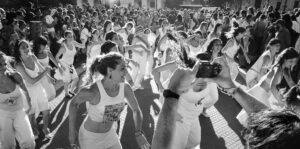Maison Vitraux, Buenos Aires 15th November.
Disorientated. We took off from Heathrow Terminal 5 at 21.50 yesterday and landed in Buenos Aires at 10.45 today. The flight was uneventful – flying long-haul is one of those occasions when uneventfulness is a bonus. Just before in-flight breakfast was served we got a glimpse of the impending sunrise: a vivid red-orange-yellow tear in the boundary between the black land and the midnight blue sky, a hint that we were arriving.
Georgina, our tour guide for Patagonia, met us at the airport and we joined the traffic into Buenos Aires in a minibus. Maison Vitraux was in a cobbled side street of San Telmo, the city’s oldest barrio. It was a radical modern makeover of an old building, very cool and stylish (but the front door always stuck and basics like lights and showers are a triumph of design over function). We freshened up and found our way down to the bar for a briefing with the rest of the party over a late breakfast that was really lunch. There were eleven of us in the group, a mix of British and Canadians. Georgina tells us: Ushuaia is pronounced ‘oo-swy-ya’ and may soon be eclipsed by Porta Williams as the world’s most southerly city; fruit and vegetables are scarce and expensive in Patagonia; the weather there is unpredictable, you can have several seasons in one hour, so good jackets and stout shoes are essential. Ground rules, like punctuality, were established.
We toured the City after lunch – Georgina’s warning to watch out for pickpockets and ‘men with sprays who will clean you out’ nagging away. It was a whistle stop tour with a slightly loopy guide, Gabriella, who encouraged us to ‘look at everything, look at the people’. We try to take in: the flea market and street dancing in St Telmo; La Boca with its football stadium and painted houses; the clouds of purple-blue jacaranda in the Plaza de le Recoleta; Eva Peron’s empty tomb (her body disappeared in 1955) in the Recoleta Cemetery; the waterfront of Puerto Madero; and Avenue 9 de Julio with 15 lanes of traffic, possibly the widest avenue in the world; and the Flores Generica Monument a giant steel and aluminium flower that opens by day and closes by night in the Parque Tres de Febrero. We ended at the Plaza de Mayo, scene of momentous events in Argentine history and huge popular demonstrations. It is the spiritual home of The Mothers of the Plaza de Mayo (Madres de los Desaprecides), in 1977 the first major group to organize against the Argentina regime’s human rights violations. Today hundreds of joyful dancers for the Super Explosion Orgullo [Pride] de Be Ae had taken it over.
Back to the hotel for a wine tasting then out to a melonga on the darkened Plaza Darrego. Here people of all aged congregated to learn and practicing the tango – it was very proper, not a pick up place, the purpose was the dance. Georgina was revealed as a skilled and sensual dancer. She said the art is to ensure that you get an experienced partner, so it’s important not to make eye contact with someone who is unlikely to be any good – once asked and you accept you are committed to a set of five dances.
Over dinner at a long table in a nearby restaurant – steak (the first of many mountains of meat) and chips – the party began to be at ease with itself. We found the way back to the hotel through darkened streets by ourselves, more by luck than judgement and feeling surprisingly unconcerned.

